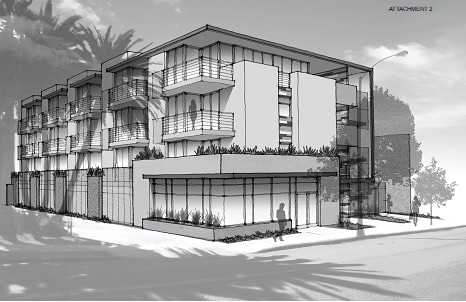City Approves $2 Million Loan for Four-Story Homeless Housing Project

Give Rob Fredericks credit for some seriously ingenious scrounging. Fredericks is the executive director of the Housing Authority for the City of Santa Barbara, and this Tuesday, he got a $2 million loan approved by the Santa Barbara City Council that will enable the Housing Authority to buy a vacant lot at 116 East Cota Street and build on it a four-story complex that will provide housing for 29 homeless people.
The loan from City Hall will cover most of the $2.6 million purchase price for the land. What makes Fredericks and his compatriots at the Housing Authority so ingenious is not so much the loan itself, but the way they found and snagged the property in the first place.
A private developer already had secured most, but not all, of the city permits necessary to build 15 market-rate, two-bedroom apartments on the two lots — located by Vera Cruz Park and across the street from the Cota Street parking lot where the Saturday Farmers’ Market takes place. Hanging the developer up were questions of access for the new tenants into and out of an alley alongside Vera Cruz Park from Cota to Haley streets. That issue was finally ironed out, but the private developers were ready to throw up their hands in exasperation.
Fredericks had been on the prowl for just such a scenario. The private developers had secured their development rights through the city’s much-debated AUD housing density program that was designed to promote the production of rental housing by giving developers such incentives as increased building densities and reduced parking requirements. That program, launched in 2013, started off extremely hot but has since cooled down considerably. In this case, it was the city’s red tape that induced the stalling. It didn’t hurt that the architect who designed the proposed four-story development for the private developers had also worked for the Housing Authority.
Even better — from Fredericks’s perspective — the Housing Authority isn’t just buying raw dirt; it’s getting a set of building plans that have already been permitted by all the city’s design review boards. Fredericks said the outside of the building remain exactly as proposed, but the insides will be reconfigured to accommodate 29 studios that will be rented out to homeless people getting off the street as opposed to 15 two-bedroom apartments. An additional unit will be built for an on-site manager. In addition, some ground-floor square footage that would have otherwise been set aside for retail space is now slated for the programs and counseling services that help tenants stay in permanent housing.
As far as the parking issue that hung the project up, that won’t be such an issue for the low-income tenants occupying the 29 new rental units. Like other Housing Authority projects providing transitional housing to homeless people, tenants living in this one will not be allowed to have cars. Most — given their incomes — won’t be able to afford them. The development will, however, provide 16 spaces for staff, visitors, and individuals providing supportive services.

The city loan will come with a few strings attached. The land will be encumbered with a 90-year restriction requiring that the development serve low- and very-low-income individuals, no matter who winds up owning it over the years. The funds have to be paid back over 30 years with 3 percent interest, but payments are required only when the income stream generated by the project allows. Tenants there will pay their freight using federal Section 8 housing vouchers.
Although a few regulatory hurdles remain to be cleared yet, Fredericks said they are relatively minor and can be obtained via a staff hearing officer as opposed to one of the city’s design review boards. Projects catering to this clientele — homeless and near-homeless people — can be met with intense opposition from surrounding neighbors. In this instance, there is no residential development nearby. And the Cota Street Parking Lot — right across the street — is currently slated to become the site for the city’s proposed new police department.
The City Council vote came just two days before the Santa Barbara County Grand Jury released a major report highlighting the growing need for more housing for homeless people. According to that report, the number of homeless people counted earlier this year in a countywide census increased by 5 percent from the number counted last year. The new official count is 1,897. Of those, 1,223 do not dwell in any of the county’s handful of homeless shelters; 629 reportedly live in their vehicles. These new 30 units — built in the style of a modern-looking glassy box — will make a small dent in the problem.
In a similar vein, the Housing Authority is still hashing out the details of new housing proposals slated for the parking lot at the intersection of Castillo and Carrillo streets. Those details should be officially released by the end of July. Fredericks said the exact number of units to be proposed there has yet to be settled upon but will probably range between 49 and 71. They will be a mix of studios, one-bedroom, and two-bedroom rentals. Targeted will be tenants with household incomes between $66,000 a year and $84,000 — the proverbial “missing middle.” These are tenants who make too much to qualify for affordable housing subsidies but not enough to be able to afford Santa Barbara’s high market rents.
Two years ago, the Housing Authority first proposed developing this lot — which provides relatively low-cost paid parking for downtown employees. It envisioned building 44 “tiny homes” that would provide transitional housing for those getting off the streets. The project itself galvanized neighborhood concern, but the short time frame allowed for public comment — just a few days — inflamed the negative reaction. (Councilmembers were given an exceptionally short time to approve the grant application that would have funded the project.) Ultimately, the Housing Authority and the council opted to pull the plug on that proposal and propose something for middle-income working tenants instead.
This time around, the decision on how dense the property should be will be made after the neighborhood and the city have a chance to give feedback, Fredericks said. The concepts will be rolled out to neighbors at several virtual community meetings in the coming months.
Correction: Regarding the Cota Street property, the alleyway access was included in the development permits that passed to the Housing Authority. Also, development studies for Castillo Street, including the results of neighborhood meetings, are likely in July, not next week.
